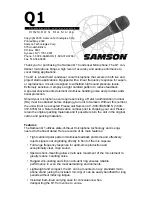
device should connect to the housing of
that device along the shortest possible
path, using DC coupling if possible, or at
least capacitive coupling.
Care of the SuperCMIT
Please make certain that the microphone is
never used in a dusty environment, and that
after use it is kept in a closed container such
as the supplied wooden case, since its func-
tioning can be affected if dust gets into the
microphone.
What to do if ...
the microphone is noisy in high humidity?
If condenser microphones are used in high
humidity or are brought in from the cold to a
warm (and humid) room, condensation can
occur, causing snapping or rattling sounds, etc.
The SuperCMIT is distinctly less subject to
this problem than analog microphones, since
its greater power consumption creates enough
warmth to hinder any moisture condensation.
But if such noises should ever occur, give the
microphone a few minutes to warm up, and
then as a rule it will again give you trouble-
free operation.
Wind noise and windscreens
Interference caused by air currents (wind, vocal
popping, movement of the microphone on
the boom or airflow through heating or venti-
lation systems) can impair the sound quality. If
the wind is mild, the simple W 170 foam
windscreen which is supplied as an accessory
can help. For strong wind there are Rycote
basket-type windscreens (see page 10).
SCHOEPS
GmbH · Spitalstr. 20 · D-76227 Karlsruhe (Durlach) · Tel: +49 721 943 20-0 · Fax: +49 721 495 750
www.schoeps.de · [email protected]
Important notes / EMC / Care
12
English
– Preset 2 (red LED): 15 dB (extremely high)
suppression of diffuse sound. This setting is
reserved for special applications; some lesse-
ning of sound quality may occur.
Important notes
Latency
Because of the >2 ms latency, it is not advisable
for most people to monitor the output of the
SuperCMIT through headphones while speak-
ing into the microphone. The two output
channels of the microphone (SuperCMIT und
CMIT) have differing latency times (see specifi-
cations on page 14), and their signals should
not be mixed together.
Sound openings
In the area around the second, rear-facing
transducer there are eight sound openings for
the sake of acoustic transparency. Please be
careful not to block these openings, e.g. with
a stand adapter or other mounting device. The
size of these openings also makes it important
to keep their gauze covering from being pressed
inward.
Notes on EMC
(Electromagnetic Compatibility)
The SuperCMIT is insensitive to magnetic, elec-
trical and electromagnetic fields. But no micro-
phone can ever be fully immune to all interfer-
ence. The following rules can help to prevent
possible interference:
– Avoid placing the microphone or its cable
close to sources of interference such as
video monitors, digital equipment (compu-
ters), transmitters (cellular phones or PDAs),
high-voltage lines, high-power AC adapters,
lighting dimmers, etc.
– Use high-quality 110
Ω
AES3 cable that is
no longer than necessary.
– Do not run microphone cables parallel to
AC power cables. If it is necessary for them
to cross, they should do so at right angles.
– The cable shield at the input of the receiving


























